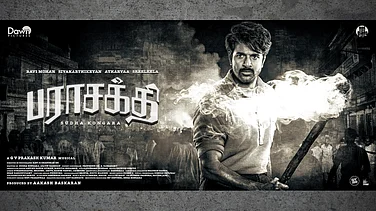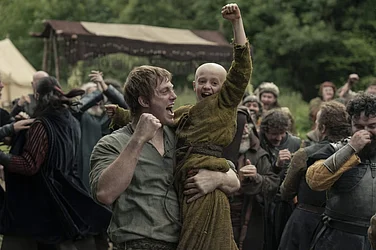THE goddess and the demon, an all-pervasive component of the Indian psyche, finally seep into contemporary art. Well-known painter Tyeb Mehta has made a series of nine powerful works which reinvent the myth in an eminently modernist metaphor. In these works which hang at New Delhi's Vadehra Art Gallery from this week, the demon buffalo's convulsive destruction evokes the frothing spectre of violence which can overpower all forms of life.
In a forceful work, Mahishasura, the buffalo who changed into a lion, then horse and finally the demon, are interlocked in fierce combat, within as much as without, sending a reeling movement across the canvas. The buffalo's anguished head which writhes in agony resonates Picasso's beast in Guernica who let out a similar howl against the ravages of war. The buffalo's pulsating body forms the diagonal anchor for the incessantly emerging beasts, their limbs and torsos overlapping, yet dismembered from each other and seeming to act of their own. If agony casts its long shadow over the forms, the blazing white figure of the demon, his face contorted with hate, dissects the centre with tremendous vitality. The dyad reveals the two fundamental aspects of human conflict where compassion and destruction are enmeshed with each other.
The legend as told primarily in the Devi Mahatmayam has it that the goddess was born of the energies of the gods to destroy the demon Mahisha terrorising the world. The buffalo-man himself has an apocalyptic origin where the demon-king Rambha gets a boon from the firegod Agni and through his union with a she-buffalo gives birth to an invincible son. His lineage then is divine as well as bestial and in his many contradictory selves lies the tormented condition of human existence. The demon becomes even more powerful due to arduous penance and then begins to lead a life of excessive indulgences. The goddess engages in a powerful duel with him and folklore has it that the two are as much attracted by each other as driven by a zealous fury.
In Mehta's compelling work the moment when the demon emerges from the buffalo is frozen, accentuating the drama. It's after a battle of thousand years that the goddess is able to defeat him and sever his head. From the dead buffalo arises the human but his head is severed again. The moment of death is near and as the buffalo-man battles ferociously, all the gut-level experiences outline his visage. The despair, anguish and fear which alternate reach a crescendo in paintings like Three Head Studies of Mahishasura. In these, Mehta explores the complex emotional forces which lie at the kernel, ceaselessly struggling with each other. The emotional contours are united in an agonising symbiosis and etched in an unrelinquishing stark white in these masterly paintings. Clearly the battle is of seismic proportions. As Ranjit Hoskote, the poet and critic, points out in the catalogue: "The persistence of the Mahishasuramardini image in the popular consciousness of India points unfailingly to the survival of a tenacious psychological complex. In the moment of divine savagery when the Devi's trident finds Mahishasura's heart, there lies exposed a cultural self that's divided between two sets of existential choices: between compassion, emotional abundance and joy on the one hand; militancy, emotional inadequacy, anxiety on the other. We could not have wished for a more concise account of the psychic crisis that faces India today."
What's the reason behind the popularity of the Mahishasuramardini myth? It refuses to be embalmed in museums but is churned out periodically from street corners and village huts. Rather than offering solutions it accentuates the paradox of life and in that cathartic osmosis lies its strength. Even in the classical stance of the deity in Mahabali-puram the opposing partners are enveloped in a ceaseless rhythmic unity. Mehta's Mah -ishasuramardini then reverberates this ancient legacy as much as it's emblematic of the strife-torn situation of contemporary life.
The Holocaust of the Partition and of a man being hacked to death before him, the many riots that have ensued since Independence, the tying and killing of the bull in the abattoir have all been infused in Mehta's trussed bulls which he has painted over and over again. The long years of making the powerful animal, his virile strength decapitated yet seething with fury seems to have at least found a release. Not in a sedate removal of tension but in the acceptance of inherent dualities.






















